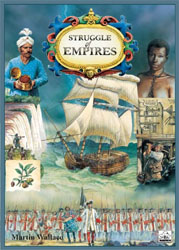We’ve all been looking forward to getting the new Warfrog game to the table ever since I got back from Essen but we’ve not had a decent opportunity when we’ve all been at the Club until tonight. Struggle of Empires is definitely a gamer’s game. It is complex in its rules and the multitude of options available to players on each turn. And it is pretty long. Knowing this, we agreed to play through just two wars rather than three as we knew this was going to be very much a learning game.
The game is set in the 18th century and is about the battle for dominance by the European powers both within Europe and the colonies. Players represent one of the European powers and command a number of forces (armies, navies and forts) with the aim of establishing control tokens in the eleven areas being fought over. Victory points are awarded according to the balance of control tokens between the players in each area. The game is played over three wars (rounds) and each war consists of a number of phases. First, counters are placed on the board, mainly representing neutral country forces (although some allow colonisation or enslavement to take place later in the round). Next comes one of the most interesting aspects of the game: alliances. Each player has to join one of two alliances and allied countries are obliged not to attack one another during the current war. However, players must bid gold to influence which countries join which alliance and this can be extremely important in keeping threatening countries at bay. Once the alliances have been formed, players have five rounds of actions, in which to develop their position on the map. This can be through introducing new armies navies or forts to the map; moving forces around; taking one of the multitude of action tiles (giving various advantages to the holder); colonising or enslaving in a country where permitted; or attacking opposing forces / neutral forces. Once these action rounds have taken place, players receive income and pay maintenance costs, following which VPs are awarded and marked on the scoring track. The game then moves onto the next war and after three wars the game is over. However, at the end, a deduction to the VP totals is made to those players whose countries have generated the most unrest at home (this having been collected by losing battles or taking certain action tiles). Most VPs after this adjustment wins.
After going through the rules and having taken medication for the headaches we had all acquired, we set off through the first war. For some reason, nobody wanted to be allied with me (Britain) but eventually John drew the short straw. The German States saw a heavy infiltration of forces from Nige and Mark K while Mark G consolidated an impenetrable position in the Baltic. John looked abroad to the Caribbean for his rewards, while I flitted around the globe trying to get a presence in lots of places. At the end of the first round, Nige had a slight VP lead with me in second. The second war saw lots of German native forces appear (not surprising with both Nige and Mark K on their doorstep. I paid to be allied with Nige and to have Nige and Mark K in opposing alliances. This made it more difficult for them to battle the German natives and Nige picked up some critical unrest through a couple of badly fought battles. Towards the end of the round, four of us chose to take tiles to reduce unrest, leaving Nige with the most unstable economy at home and losing him 7VPs. This proved critical in pushing him back into second place behind me.
We all enjoyed this and were only really starting to delve into the options by the end. I think a third war would have added more to the game by allowing for more longer-term planning and we didn’t concentrate overly on the action tiles. The game took just over two hours after the lengthy rules summary so it should just fit into a normal evening session now we’ve played it once. One thing we felt was a little strange (I hope we didn’t miss a rule) was that, once you had a control token in an area, if you then moved your forces out, the CT would stay there without fear of attack and continue to generate VPs at the end of each war. This was particularly obvious in the Ottoman Empire where I drew a CT in my initial set up (the only player to do so) and the native force was very strong. This meant nobody moved any forces in there and I was the only one to score in that area each round. Others would have liked to attack me in that area but as I had no units there, they couldn’t. Anyway, overall a very involving and interesting game with lots to try. I liked it a lot and hope we will play again soon.
|

